BenQ XL2720T Gaming Monitor Reviewed
by Chris Heinonen on June 17, 2013 4:35 PM ESTWith TN panels you are of course subject to the problem of poor viewing angles in comparison to other monitor technologies. The problem also accentuates itself on larger displays like the XL2720T, where the viewing angle is larger for your vision, and so the edges start to have color shifts even when you are directly centered on the screen. Even with regular content on the screen, I can notice shifts in contrast and color at the edges of the screen in general use, which I find distracting. I didn’t notice it vertically as much, but the angle isn’t nearly as large as with the horizontal position.
I also found the overall look of the XL2720T to be a bit worse than with other displays I have had in recently. Perhaps it’s the anti-glare coating, but everything looks slightly fuzzy, even the simple black text in this document that I’m typing right now. With the lower resolution I’d expect to see more sharp angles and pixels, but everything looks a bit too smoothed out because of this issue. I have to say that for general use, I can’t imagine living without an IPS monitor at this point.
The BenQ has a lot of preset modes available for calibration, but the best data was obtained with the sRGB mode. Standard was a bit better for grayscale, but color accuracy was better in sRGB making it the overall best choice. Surprisingly, Photo mode was far and away the worst preset on the BenQ when it comes to accuracy, even more than the FPS modes are. Perhaps they meant to call it “Galaxy S3 Photo Mode”, but I’d usually expect a mode for viewing photos to be accurate. So just don’t use it, unless you want a really vivid Instagram filter applied to all your photos on your PC.
The uncalibrated grayscale performance for the BenQ is decent though not outstanding. The average dE2000 is just below 3.0, which is the visible threshold. As you look at the RGB balance you can see there is a distinct blue-green tint to the grayscale, which you can easily see on screen as well. The gamma comes out just above 2.0, well off our 2.2 target, and it isn’t linear at all which will lead to images that are a little dark in the shadows and too washed out in the highlights. The contrast ratio of 706:1 is on the low side, but the gamma issue really leads to a bit of a washed out image.
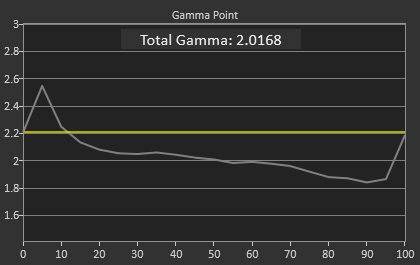
The color points are much better, with a dE2000 of 2.1 and most luminances are pretty close to correct, with all the colors having a dE2000 below 3. The worst issue is the 100% saturation, 100% luminance white that throws the average off a bit, and that will be noticeable as that’s your background white in most applications. Overall you get good numbers for a preset mode.
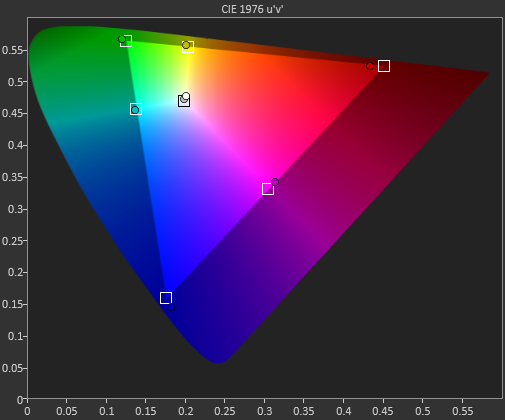
The colorchecker tests look good overall with the exception of two orange shades that are well off their target. Every other color has a color error that is practically invisible, as long as it isn’t right next to a correct sample. The biggest issue is that the luminance levels are too high across the board, and luminance is the most noticeable error in color.
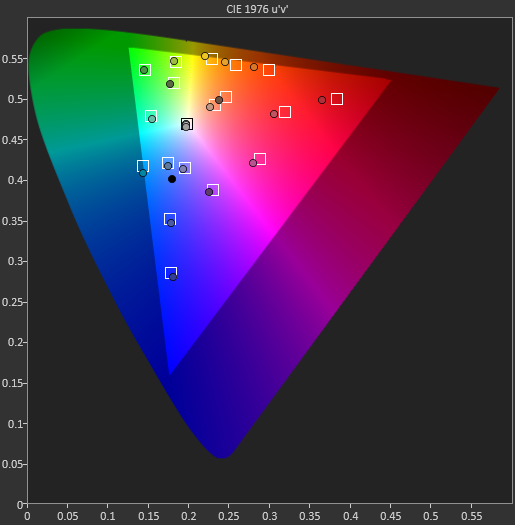
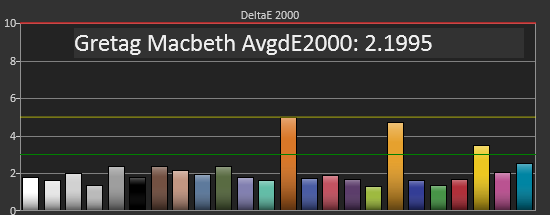

Our saturations data is also very good, showing very uniform errors across the spectrum, and no really large spikes to be heavily concerned with. Overall for a pre-calibrated mode, the sRGB does a good job on the BenQ XL2720T.
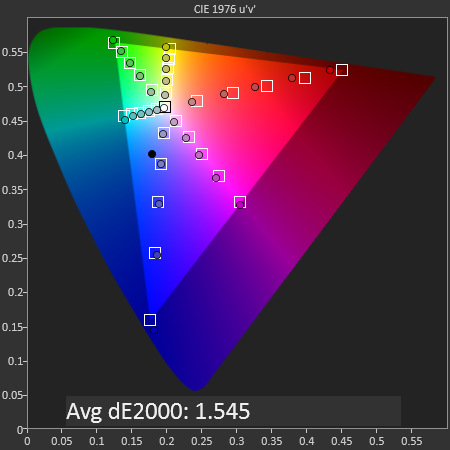
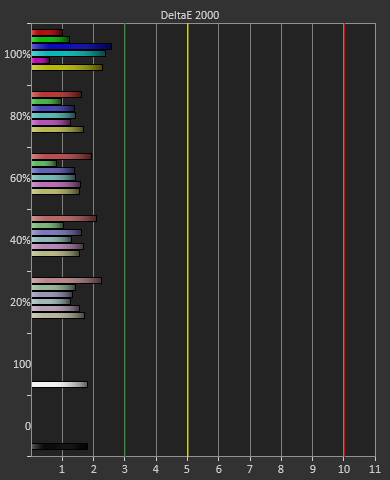
Looking at the gamut, we see just below 71% of the AdobeRGB gamut, which is what sRGB should measure out at.
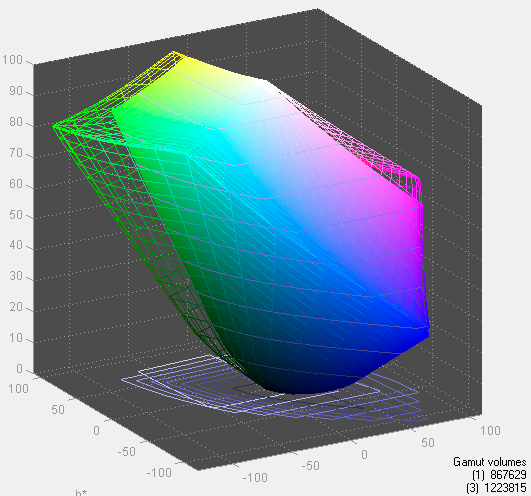
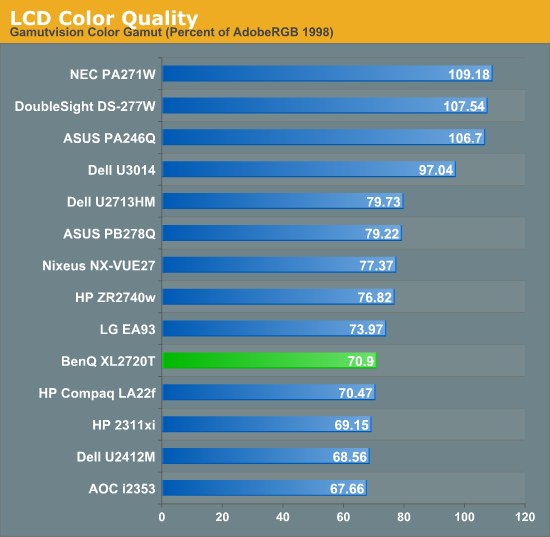









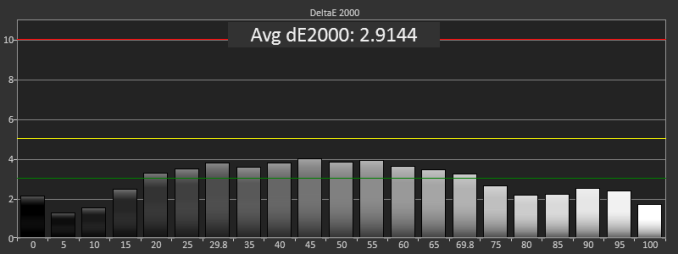










79 Comments
View All Comments
Panzerknacker - Tuesday, June 18, 2013 - link
Yes they did, TN panels just produce such mediocre image quality that there is no immersion anymore of any kind. Lighting effects are just colored spots on a TN, black levels are non existant, if you move from CRT to TN you will just give up on gaming, trust me. Plasma is the best of the currently available displays, good respons and superior image quality, but they start at 40 inches which is too big and you cannot comfortable use them for still images such as desktop due to burn in problems.qiplayer - Saturday, November 9, 2013 - link
See my 5800x1080 fast gaming on youtube channel qiplayer. Im here looking for 120hz, I actually own 3 asus ve278, the image is great the only downside is blur image when moving fast. But whatch the vid, you'll see that you can actually game quite fast also on 60hz monitors.bji - Monday, June 17, 2013 - link
The retina display in my macbook pro looks better than any CRT I ever saw, hands down.Also I put an older Mitsubishi Diamondtron 21 inch next to a fairly old Dell 24 inch IPS panel and I didn't find that I favored one over the other.
BillyONeal - Monday, June 17, 2013 - link
The retina is an IPS panel, so I don't see what point you're trying to make here.A5 - Monday, June 17, 2013 - link
You must only be remembering the good CRTs. Bad CRTs were really, really bad.Not to mention heavy, power inefficient, giant bezels, expensive, etc. I sure as hell wouldn't be able to afford 2 1080p+ CRT monitors, and they probably wouldn't fit on my desk, either.
mdrejhon - Tuesday, June 18, 2013 - link
Panzerknacker, have you tested LightBoost? Google "LightBoost:They give you perfect CRT quality sharp motion on an LCD:
-- Fast panning as perfectly sharp as stationary images.
-- I can read text even during fast scrolling
zehoo - Tuesday, June 18, 2013 - link
Perhaps you should try one of the Korean IPS or PLS 2560x1440 panels that overclock to 120hz if you want better colour reproduction than a TN panel while still having low input latency (models with OSD bypass) and a decent refresh rate. I haven't been able to go back to a 1080 TN 120hz panel since using one.Of course 120hz TN lightboost hack panels is where it's at for the moment if you need low input latency and fast refresh rates for competitive gaming. The trade off being superior colours. By the way I moved from CRT to LCD and didn't stop gaming. Though I only moved when 120hz TN panels first became available.
EnzoFX - Monday, June 17, 2013 - link
Processing lag. I would think this would still be #1 priority for a gamer. I'm surprised it's so high.Guspaz - Monday, June 17, 2013 - link
The first page is called "INTRODUCTION, DESIGN AND SPECS", but there are no specs on the page. I don't even see any mention of the resolution. Is it 1920x1080, 1920x1200, 2560x1440, 2560x1600? There should be a table on this page listing all the details: manufacturer, model, size, resolution, panel type, price, inputs, etc.metril - Monday, June 17, 2013 - link
The first thing I looked for was the monitor resolution and other necessary information. I found nothing. How am I supposed to trust this review if none of the relevant information is presented?